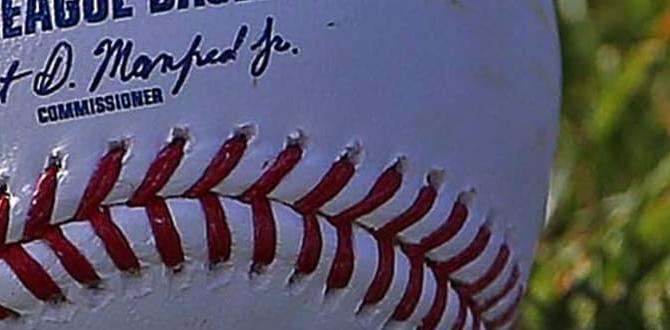Winning fantasy baseball isn’t about luck; it’s about smart strategy. Master key principles like player evaluation, draft tactics, and in-season management to build a championship team.
Playing fantasy baseball can feel like a puzzle. You pick players, watch them play, and hope for the best. But what if there was a way to make those picks smarter? What if you could approach your fantasy league with a plan that actually works? Many players wonder how to get ahead, feeling frustrated when their team doesn’t perform like they hoped. Don’t worry! This guide will break down proven strategies, making it simple for you to build a winning fantasy baseball team. Get ready to transform your approach and aim for that championship.
The Foundation of a Winning Fantasy Baseball Strategy
Building a successful fantasy baseball team starts long before draft day. It’s about understanding the core principles that lead to consistent success. Think of it like preparing for a baseball game – you need the right gear, a good warm-up, and a solid game plan. In fantasy, that means knowing your league rules, understanding player value, and having a clear vision for your team.
Understanding Your League Settings
Every fantasy league is a little different. Some use head-to-head matchups, while others use total categories. The scoring system – be it roto or points – dramatically impacts player values. For example, in a points league, a player with a high batting average might be less valuable than a player who hits for power and drives in runs, even if their AVG is lower. Knowing these nuances is crucial. Researching common scoring formats can give you a good baseline.
Player Valuation: Beyond the Hype
It’s easy to get caught up in the names and the big stories. But a truly strategic player looks deeper. This means understanding advanced stats and recognizing undervalued assets.
Batting Average (AVG): dominates contact hitters.
On-Base Percentage (OBP): values players who get on base, crucial for runs scored.
Slugging Percentage (SLG): highlights power hitters.
Weighted On-Base Average (wOBA): a more comprehensive stat that accounts for the overall value of each possible offensive outcome.
ERA and WHIP for pitchers: crucial for minimizing runs against.
Tools like FanGraphs and Baseball-Reference offer a treasure trove of data to help you evaluate players accurately. Looking at a player’s recent performance history alongside their underlying stats can reveal trends and predict future output. Remember, consistent production is key.
Draft Day Domination: Your Blueprint for Success
Draft day is where the magic begins. It’s your chance to assemble the core of your team. A well-executed draft can set you up for the entire season. This involves preparation, understanding draft ADP (Average Draft Position), and knowing when to stick to your plan and when to be flexible.
Pre-Draft Preparation is Key
Don’t go into your draft blind. With all the information available, being unprepared is a disservice to yourself.
Mock Drafts: Simulate your draft multiple times. This helps you get a feel for player availability and practice different strategies.
Create Tiers: Group players into tiers based on their expected performance. If you miss out on a top-tier player, you know who the next best options are in the subsequent tier.
Know Your Draft Slot: Your draft position influences your early-round strategy. Picking near the turn (e.g., 1.04/1.05 or 1.08/1.09) allows for back-to-back picks, which can be an advantage.
Research Rookies and Deep Sleepers: Identifying breakout candidates early can give you a significant edge.
Mastering ADP and Finding Value
ADP tells you when players are typically drafted. You can use this to your advantage.
Drafting Value: Don’t just pick the best player available according to generic rankings. Target players who are falling past their ADP. This is where you find “value.”
Avoiding Reach: Conversely, don’t reach too early for a player if they are consistently being drafted much later. You might be able to get them in a later round.
Positional Scarcity: Be aware of positions that have fewer elite options. If you can secure a top player at a scarce position early, it might be worth it. However, don’t overpay for a position with plenty of depth.
Draft Strategies and Archetypes
Different draft strategies can work, depending on your approach and league.
The “Stars and Scrubs” Approach: Focus on acquiring elite talent in the early rounds and then filling out your roster with cheaper, high-upside players later. This can lead to explosive performance but also significant risk if the “scrubs” don’t pan out.
Balanced Approach: Spread your talent evenly across all rounds, aiming for solid, reliable production at every position. This is generally a more conservative and consistent strategy.
Middle Starters: This strategy involves targeting solid, mid-round players who provide good value and filling your late rounds with high-upside prospects or players in favorable situations.
Example Draft Round Considerations:
| Round | Strategy Focus | Potential Targets (Illustrative) |
| :——– | :——————————————– | :——————————- |
| 1-3 | Elite hitters or pitchers, anchor players | Trout, Betts, deGrom, Scherzer |
| 4-7 | Solid starters, address positional needs | Semien, Olson, Cole, Glasnow |
| 8-12 | High-upside young players, proven veterans | Acuña Jr., Ohtani, Walker Jr. |
| 13-16 | Depth, sleepers, late-round potential stars | Prospects, role players |
| 17-20 | Saves/Holds specialists, bench depth | Bullpen arms, fliers |
This table is just an illustration. Player performance and ADP change constantly. Always do your own research!
In-Season Management: The Art of the Hustle
The draft is just the beginning. The real genius in fantasy baseball often shines through during the season. Adapting to injuries, waiver wire gems, and strategic trades can make the difference between a good team and a championship team.
Navigating the Waiver Wire
The waiver wire is your best friend for filling holes and finding hidden talent.
Monitor Hot and Cold Streaks: Keep an eye on players who are unexpectedly performing well or struggling. Sometimes a slump is just a slump, but other times it signals a change in role or a new opportunity.
Target Opportunity: Look for players who are getting increased playing time due to injuries or poor performance by others. A starting job is a golden ticket in fantasy baseball.
Injuries: When a star player goes down, their direct backup often becomes an immediate waiver wire target.
Set-and-Forget Pitchers: Stream pitchers by targeting favorable matchups, especially against weaker offenses or in teams with poor hitting. Be wary of streaming against potent offenses or in hitter-friendly ballparks.
Resources like preseason projections can help you identify overlooked players who may be due for a breakout as opportunities arise.
Trade Savvy: Negotiating Like a Pro
Trades are a powerful tool to improve your team. However, they require careful consideration and skillful negotiation.
Identify Needs: Know what your team lacks and what your opponents need. A trade should ideally benefit both parties, but you want to come out ahead.
Don’t Trade from Weakness (Unless You Get a Huge Return): If you’re deep at a position, you can afford to trade from it. But be careful not to gut your team by trading away your only reliable options.
Consider Long-Term Value: Don’t just think about this week. Consider how a trade impacts your team over the next month or even for the rest of the season.
Be Realistic: Understand a player’s true value. Don’t overvalue your own players or undervalue your opponent’s. Using average draft position data and recent performance can help keep you grounded.
Managing Your Pitching Staff
Pitching is often the most volatile part of fantasy baseball. Managing it effectively is crucial.
Saves and Holds: In leagues that count these categories, identifying reliable closers and setup men is paramount. Keep an eye on bullpen shake-ups.
Starting Pitcher Management: Decide when to cut bait on an underperforming starter. Streamers can be effective for filling in for bye weeks or injured pitchers, but be smart about your matchups.
Strikeouts and ERA/WHIP: Prioritize pitchers who miss bats (high K rates) and limit baserunners and runs. Some players might have a great ERA but a poor WHIP, or vice-versa, so look at both.
According to MLB.com’s official site, Pitcher usage and workloads are carefully managed by MLB teams, impacting fantasy performance. Understanding injury reports and manager tendencies can offer insight into potential role changes for pitchers. MLB’s approach to pitching usage can directly influence your fantasy decisions.
Advanced Fantasy Baseball Strategies
Once you’ve mastered the basics, you can explore more advanced techniques to gain a competitive edge. These strategies require a deeper understanding of the game and your league.
Understanding Stat Categories and How to Win Them
In roto leagues, you’re not just trying to have the “best” team, but a team that excels in enough categories to finish at the top. Certain categories are harder to win than others.
Easier Categories: Often include Home Runs (HR), Runs Scored (R), and RBIs. Power hitters can rack these up.
Harder Categories: Typically AVG, Stolen Bases (SB), and Wins for pitchers. These require specialized players.
If you can dominate categories that others struggle with, you can afford to be average or slightly below in categories where you have less specific talent. For instance, if you have elite speed and OBP players, you might be able to afford to punt batting average (meaning you don’t prioritize it highly). A comprehensive guide on winning roto categories is available on many sports analytics sites that delve into fantasy sports strategy.
The Art of “Punting” a Category
“Punting” means intentionally giving up on a particular stat category to heavily invest in others. This allows you to maximize your strengths.
Common Punts: Often include Saves, Stolen Bases, or Batting Average.
Why Punt? If you have a dominant pitching staff that excels in ERA and WHIP, you might be able to punt Saves. If you have incredible power, you might punt AVG.
Execution is Key: If you decide to punt a category, you must ensure you’re getting elite production in the categories you are focusing on. This strategy is high-risk, high-reward.
Utilizing Advanced Metrics for Projections
Beyond basic stats, advanced metrics offer a more nuanced view of player performance and potential.
xFIP (Expected Fielding Independent Pitching): This metric aims to measure a pitcher’s performance by only looking at results the pitcher has direct control over: strikeouts, walks, and home runs. It removes the influence of luck or defense. You can find xFIP data on sites like FanGraphs.
wRC+ (Weighted Runs Created Plus): This stat measures a player’s offensive value per plate appearance and adjusts for park factors, comparing it to the league average (100). A wRC+ of 120 means the player is 20% better than the league average offensively.
SIERA (Skillful Independent ERA Estimator): Similar to xFIP, SIERA attempts to isolate pitcher skill from luck and defense, often considered a more predictive stat than xFIP for future performance.
These metrics can help identify pitchers who are due for regression or improvement, and hitters who are hitting the ball well but are perhaps unlucky with their batting average.
Essential Fantasy Baseball Tools and Resources
To truly excel, you need the right tools. A baseball player uses a good glove and a balanced bat; a fantasy manager uses data and analysis.
Fantasy Baseball Websites: Sites like ESPN Fantasy Baseball, Yahoo! Fantasy Sports, and CBS Sports Fantasy are popular platforms for playing and managing leagues.
Advanced Stats Sites: FanGraphs, Baseball-Reference, and Brooks Baseball provide in-depth statistical analysis and projections.
News and Injury Updates: Follow beat writers and reputable sports news outlets for the latest on player news, injuries, and lineup changes.
Draft Tools: Many fantasy platforms offer draft assistants, and there are third-party tools that provide draft rankings and mock draft simulators.
* Rookie Scouting Reports: Websites like MLB Pipeline provide detailed information on emerging prospects.
The National Institute on Aging provides general health information that can be applied to any athlete, including understanding how to manage fatigue and recovery, which can be relevant to players on your fantasy team enduring long seasons. While not specific to fantasy sports, recognizing the importance of player well-being is a smart meta-strategy.
Frequently Asked Questions
Q1: What is the most important stat in fantasy baseball?
A1: It depends on your league’s scoring. However, on-base percentage (OBP) and slugging percentage (SLG) are often more valuable than batting average (AVG) because they measure a player’s overall contribution to scoring runs. For pitchers, a low ERA and WHIP, along with a high strikeout rate, are generally most important.
Q2: How do I find “sleepers” in fantasy baseball?
A2: Sleepers are players who underperform their draft position. Look for players with a change in scenery (new team), a new coaching staff, a reduced role that’s about to open up, or players with strong underlying metrics who are due for positive regression. Also, keep an eye on talented prospects who are close to making their MLB debut.
Q3: When should I drop a player in fantasy baseball?
A3: You should consider dropping a player if they are consistently not performing, injured with no clear timeline for return, or have lost their starting job. Always check if there’s a waiver wire pickup with higher upside before dropping someone. Don’t be afraid to cut bait on a player who isn’t contributing, but do so strategically.
Q4: What is “draft and hold” strategy?
A4: This strategy involves drafting players with high upside in early rounds and then rostering them for the entire season, even if they struggle initially. It’s common in daily fantasy sports or leagues where roster moves are limited. The goal is to ride the waves of performance for players you believe in long-term.
Q5: How can I improve my chances of winning my fantasy league?
A5: Consistent research, active management of your roster (waiver wire, trades), understanding your league settings, and employing smart draft strategies are key. Staying informed about player news and analytics will give you an edge over less engaged managers.
Q6: Is it better to draft pitching early or late?
A6: This is a debated topic. “Reaching” for pitching early can secure top talent but might cause you to miss out on elite hitters. Waiting on pitching can mean taking on more risk but allows you to build a stronger offensive core. Many successful managers opt for a balanced approach, taking a top pitcher and then focusing on hitters, or vice versa.
Q7: What does it mean to “punt” a stat category?
A7: Punting a category means intentionally forfeiting your chances of winning that specific stat category to allocate more resources (draft picks, waiver claims) to other categories where you can be dominant. For example, you might punt saves to build a pitching staff with elite ERA and WHIP.
Conclusion: Your Path to Fantasy Baseball Glory
Mastering fantasy baseball strategy is an ongoing journey. It’s about more than just picking the most famous players. It’s about research, understanding value, and adapting throughout the season. By focusing on your league’s unique settings, leveraging advanced stats, preparing diligently for your draft, and staying active with in-season management, you can build a truly competitive team. Remember, the “genius wins” not by luck, but by having a smart, well-executed plan. Keep learning, keep tweaking your strategy, and most importantly, have fun playing the game you love. With dedication and the right approach, that championship trophy can absolutely be yours.





